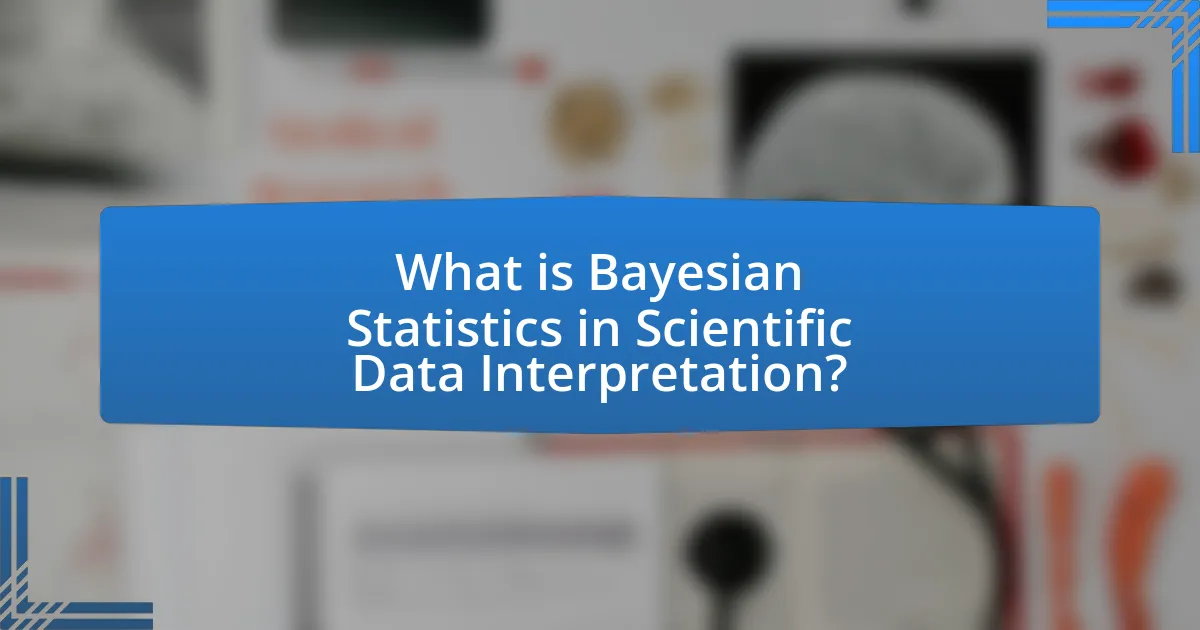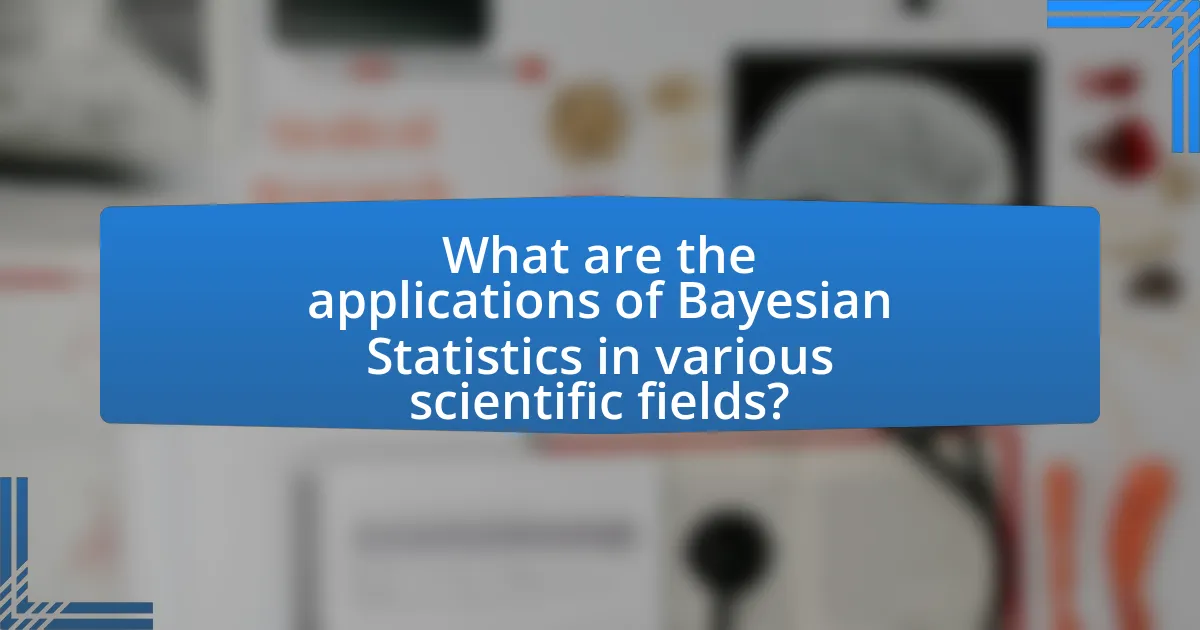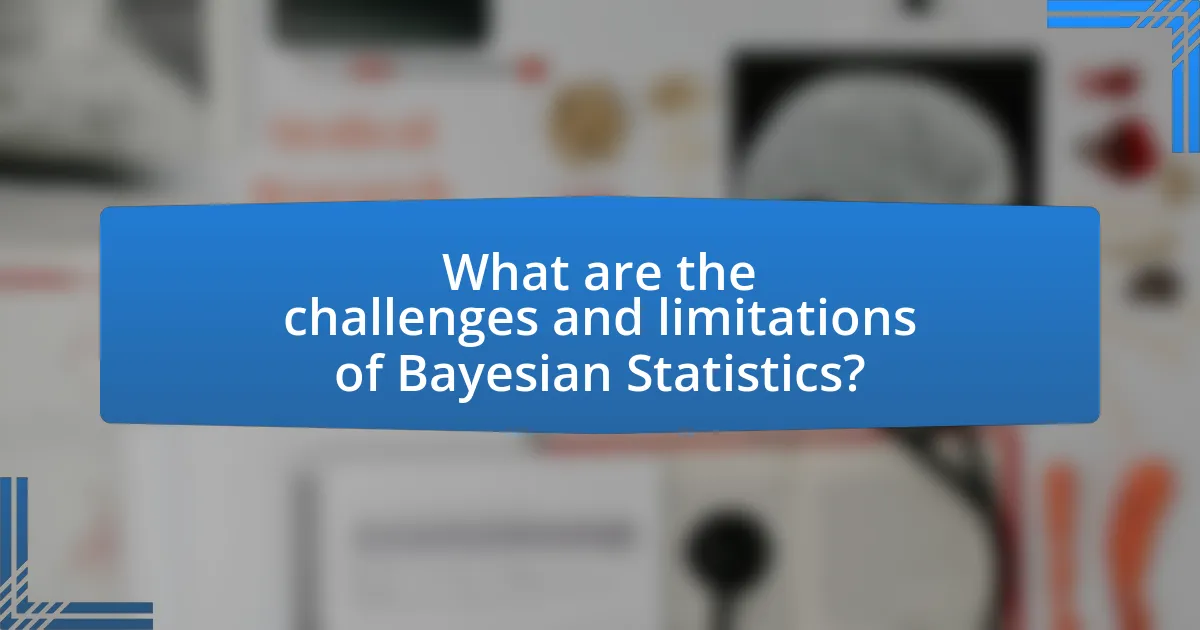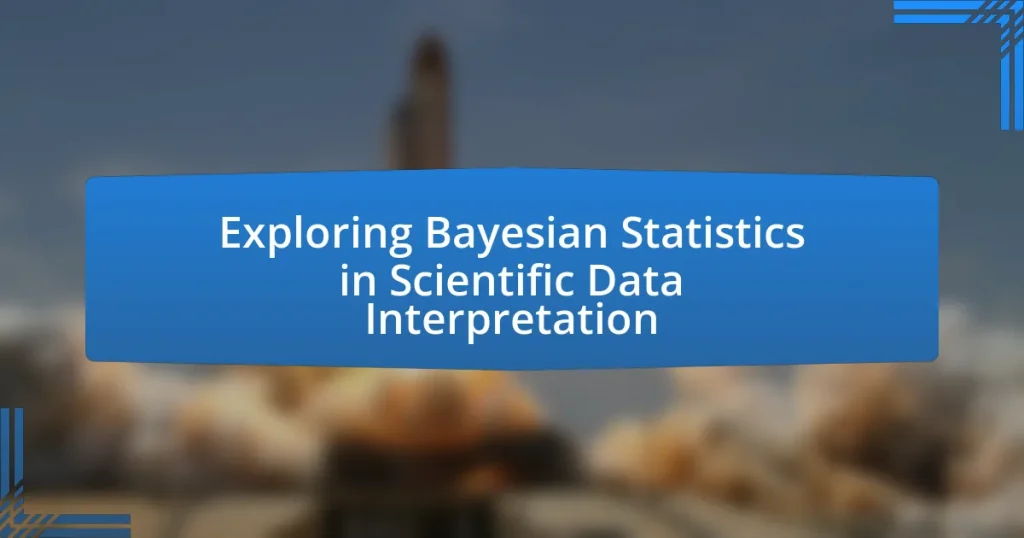Bayesian statistics is a statistical framework that utilizes Bayes’ theorem to interpret scientific data by integrating prior knowledge with new evidence. This article explores the fundamental principles of Bayesian statistics, highlighting its differences from traditional frequentist methods, its applications across various scientific fields, and its significance in enhancing decision-making and diagnostic accuracy. Key topics include the role of prior distributions, the advantages of Bayesian methods in data interpretation, and the challenges associated with their implementation. Additionally, the article addresses common misconceptions and outlines future trends in Bayesian statistics, particularly in relation to machine learning and computational advancements.

What is Bayesian Statistics in Scientific Data Interpretation?
Bayesian statistics is a statistical paradigm that interprets data through the lens of Bayes’ theorem, allowing for the incorporation of prior knowledge alongside new evidence. This approach enables scientists to update the probability of a hypothesis as more data becomes available, facilitating a more dynamic understanding of uncertainty in scientific research. For instance, in clinical trials, Bayesian methods can adjust the probability of treatment effectiveness based on accumulating patient data, leading to more informed decision-making. The validity of Bayesian statistics is supported by its widespread application in various fields, including medicine, where it has been shown to improve diagnostic accuracy and treatment outcomes.
How does Bayesian Statistics differ from traditional statistical methods?
Bayesian statistics differs from traditional statistical methods primarily in its approach to probability and inference. While traditional methods, often referred to as frequentist statistics, rely on long-run frequencies of events to make inferences, Bayesian statistics incorporates prior beliefs and evidence to update the probability of a hypothesis as new data becomes available. This is exemplified by Bayes’ theorem, which mathematically expresses how to update the probability of a hypothesis based on observed data. For instance, in clinical trials, Bayesian methods allow researchers to continuously update the probability of treatment effectiveness as new patient data is collected, unlike frequentist methods that typically analyze data only after all observations are made. This fundamental difference enables Bayesian statistics to provide a more flexible and intuitive framework for decision-making under uncertainty.
What are the key principles of Bayesian Statistics?
The key principles of Bayesian Statistics include the use of prior distributions, the application of Bayes’ theorem, and the concept of posterior distributions. Prior distributions represent the initial beliefs about a parameter before observing data, while Bayes’ theorem mathematically updates these beliefs in light of new evidence. The posterior distribution, resulting from this update, reflects the revised beliefs after considering the data. This framework allows for a coherent method of incorporating prior knowledge and uncertainty into statistical analysis, making it particularly useful in scientific data interpretation.
How does prior knowledge influence Bayesian analysis?
Prior knowledge significantly influences Bayesian analysis by serving as the prior distribution in the Bayesian framework. This prior distribution encapsulates the beliefs or information about a parameter before observing the data, directly affecting the posterior distribution after data is incorporated. For instance, if prior knowledge suggests a parameter is likely to be within a certain range, the Bayesian analysis will reflect this belief, leading to a posterior that is more concentrated in that range compared to a non-informative prior. Studies have shown that incorporating strong prior knowledge can lead to more accurate parameter estimates and improved predictive performance, as evidenced by research conducted by Gelman et al. (2013) in “Bayesian Data Analysis,” which highlights the importance of prior distributions in shaping the outcomes of Bayesian inference.
Why is Bayesian Statistics important in scientific research?
Bayesian statistics is important in scientific research because it provides a robust framework for updating beliefs based on new evidence. This approach allows researchers to incorporate prior knowledge and quantify uncertainty, leading to more informed decision-making. For instance, in clinical trials, Bayesian methods enable continuous monitoring of data, allowing for adaptive designs that can improve patient outcomes and resource allocation. Studies have shown that Bayesian techniques can yield more accurate predictions and enhance the interpretation of complex data sets, as evidenced by their application in fields such as genetics and epidemiology, where traditional methods may fall short.
What advantages does Bayesian Statistics provide in data interpretation?
Bayesian Statistics offers several advantages in data interpretation, primarily through its ability to incorporate prior knowledge and update beliefs based on new evidence. This approach allows for a more flexible and nuanced understanding of data, as it combines prior distributions with likelihoods to produce posterior distributions, which reflect updated beliefs after observing data.
For instance, in clinical trials, Bayesian methods enable researchers to continuously update the probability of treatment effectiveness as new patient data becomes available, leading to more informed decision-making. Additionally, Bayesian Statistics provides a coherent framework for handling uncertainty, allowing for probabilistic interpretations of results, which can be more intuitive for stakeholders.
The use of Bayesian models has been validated in various fields, including medicine and finance, where they have demonstrated improved predictive accuracy and better handling of complex data structures compared to traditional frequentist methods.
How does Bayesian Statistics enhance decision-making in science?
Bayesian Statistics enhances decision-making in science by providing a systematic framework for updating beliefs based on new evidence. This approach allows scientists to incorporate prior knowledge and quantify uncertainty, leading to more informed conclusions. For instance, in clinical trials, Bayesian methods enable researchers to continuously update the probability of treatment effectiveness as data accumulates, which can lead to quicker and more ethical decisions regarding patient care. The flexibility of Bayesian analysis also facilitates the integration of diverse data sources, improving the robustness of scientific findings.

What are the applications of Bayesian Statistics in various scientific fields?
Bayesian statistics is widely applied across various scientific fields, including medicine, ecology, and machine learning. In medicine, Bayesian methods are used for clinical trial design and analysis, allowing researchers to update the probability of treatment effectiveness as new data emerges. For instance, a study published in the Journal of the American Statistical Association demonstrated how Bayesian approaches can improve decision-making in personalized medicine by incorporating prior knowledge and patient-specific data.
In ecology, Bayesian statistics aids in modeling species distributions and understanding ecological processes, as seen in research published in the journal Ecology Letters, where Bayesian hierarchical models were employed to analyze the effects of climate change on biodiversity.
In machine learning, Bayesian techniques are fundamental for developing algorithms that can learn from data and make predictions, as evidenced by the widespread use of Bayesian networks in artificial intelligence applications. A notable example is the work by Judea Pearl, which established a framework for probabilistic reasoning using Bayesian networks.
These applications illustrate the versatility and effectiveness of Bayesian statistics in enhancing data interpretation and decision-making across diverse scientific disciplines.
How is Bayesian Statistics used in medical research?
Bayesian statistics is used in medical research to update the probability of a hypothesis as more evidence becomes available. This approach allows researchers to incorporate prior knowledge and clinical expertise into the analysis, leading to more informed decision-making. For instance, in clinical trials, Bayesian methods can be employed to evaluate treatment efficacy by continuously updating the probability of success based on accumulating data, which can result in more adaptive trial designs. A notable example is the use of Bayesian hierarchical models in meta-analyses, where data from multiple studies are combined to provide a more comprehensive understanding of treatment effects. This method enhances the robustness of conclusions drawn from medical research by allowing for the integration of diverse data sources and uncertainty quantification.
What role does Bayesian analysis play in clinical trials?
Bayesian analysis plays a crucial role in clinical trials by allowing for the incorporation of prior knowledge and real-time data updates to inform decision-making. This statistical approach enables researchers to update the probability of a hypothesis as more evidence becomes available, which is particularly useful in adaptive trial designs. For instance, Bayesian methods can facilitate the continuous monitoring of trial data, allowing for modifications in treatment allocation based on interim results, thereby optimizing patient outcomes and resource utilization. The flexibility of Bayesian analysis has been recognized in regulatory guidelines, such as those from the FDA and EMA, which endorse its use for making informed decisions throughout the trial process.
How does Bayesian Statistics improve diagnostic accuracy?
Bayesian statistics improves diagnostic accuracy by integrating prior knowledge with new evidence to update the probability of a diagnosis. This approach allows for a more nuanced understanding of the likelihood of conditions based on both historical data and current test results. For instance, a study published in the Journal of the American Medical Association demonstrated that Bayesian methods can reduce false positives in cancer screening by incorporating patient-specific factors and previous test outcomes, leading to more accurate diagnoses. This method enhances decision-making in clinical settings by providing a probabilistic framework that reflects the uncertainty inherent in medical diagnostics.
What are the implications of Bayesian Statistics in environmental science?
Bayesian statistics significantly enhances decision-making in environmental science by allowing researchers to incorporate prior knowledge and update beliefs based on new data. This approach is particularly useful in modeling complex ecological systems, where uncertainty is prevalent. For instance, Bayesian methods can improve species distribution modeling by integrating historical data with current observations, leading to more accurate predictions of species responses to environmental changes. Studies, such as those by McCarthy et al. (2013) in “Ecological Applications,” demonstrate that Bayesian frameworks can effectively quantify uncertainty in ecological forecasts, thereby aiding in conservation planning and resource management.
How can Bayesian models predict climate change impacts?
Bayesian models can predict climate change impacts by incorporating prior knowledge and updating predictions as new data becomes available. These models utilize probabilistic frameworks to quantify uncertainty in climate projections, allowing for more robust assessments of potential impacts. For instance, a study published in “Nature Climate Change” by Knutti and Sedláček (2012) demonstrated that Bayesian methods can effectively integrate various climate models and observational data, leading to improved estimates of temperature rise and its associated effects on ecosystems and human systems. This approach enhances decision-making by providing a clearer understanding of the range of possible climate outcomes and their probabilities.
What are the benefits of using Bayesian methods in ecological studies?
Bayesian methods offer several benefits in ecological studies, including the ability to incorporate prior knowledge and uncertainty into models. This approach allows researchers to update their beliefs based on new data, leading to more accurate predictions and inferences about ecological processes. For instance, Bayesian hierarchical models can effectively handle complex data structures and varying levels of uncertainty, which are common in ecological research. Additionally, Bayesian methods facilitate the estimation of parameters and the quantification of uncertainty, providing credible intervals that enhance the interpretability of results. Studies have shown that Bayesian approaches can outperform traditional frequentist methods in terms of predictive accuracy and flexibility, making them particularly valuable in the dynamic field of ecology.

What are the challenges and limitations of Bayesian Statistics?
Bayesian statistics faces several challenges and limitations, primarily related to computational complexity, subjective prior selection, and model sensitivity. The computational complexity arises from the need for sophisticated algorithms, such as Markov Chain Monte Carlo (MCMC), to estimate posterior distributions, which can be resource-intensive and time-consuming, especially with large datasets. Subjective prior selection can introduce bias, as the choice of prior distributions significantly influences the results; this subjectivity can lead to disputes among researchers regarding the appropriateness of chosen priors. Additionally, Bayesian models can be sensitive to the assumptions made, which may affect the robustness of conclusions drawn from the analysis. These challenges highlight the need for careful consideration and expertise when applying Bayesian methods in scientific data interpretation.
What common misconceptions exist about Bayesian Statistics?
Common misconceptions about Bayesian Statistics include the belief that it is solely subjective, that it requires prior distributions to be accurate, and that it is only applicable in specific fields. Bayesian Statistics is not inherently subjective; it allows for the incorporation of prior knowledge but also provides a framework for updating beliefs based on new evidence. The requirement for prior distributions is often overstated; Bayesian methods can be applied with non-informative priors when prior knowledge is lacking. Additionally, Bayesian Statistics is versatile and applicable across various domains, including medicine, finance, and machine learning, contrary to the misconception that it is limited to niche areas.
How can misunderstanding of prior distributions lead to errors?
Misunderstanding of prior distributions can lead to significant errors in Bayesian analysis by causing incorrect inferences and predictions. When researchers misinterpret the prior distribution, they may assign inappropriate probabilities to parameters, which skews the posterior distribution and ultimately affects decision-making. For instance, if a prior is overly optimistic or pessimistic, it can distort the results, leading to conclusions that do not accurately reflect the underlying data. Studies have shown that incorrect priors can result in misleading confidence intervals and hypothesis tests, as evidenced by a 2016 paper by Gelman et al., which highlights how improper priors can lead to erroneous conclusions in scientific research.
What are the computational challenges associated with Bayesian methods?
Bayesian methods face several computational challenges, primarily due to the complexity of posterior distributions and the need for efficient sampling techniques. The computation of posterior distributions often involves high-dimensional integrals that are analytically intractable, necessitating the use of methods like Markov Chain Monte Carlo (MCMC) for approximation. MCMC methods can be computationally intensive and may converge slowly, particularly in high-dimensional spaces, leading to long run times and increased resource consumption. Additionally, the choice of prior distributions can significantly affect the computational efficiency and the resulting inferences, complicating model selection and validation processes. These challenges are well-documented in literature, such as in the work by Gelman et al. (2013) in “Bayesian Data Analysis,” which highlights the difficulties in implementing Bayesian methods effectively in practice.
How can researchers effectively implement Bayesian Statistics?
Researchers can effectively implement Bayesian Statistics by utilizing prior distributions, updating beliefs with new data through Bayes’ theorem, and employing computational techniques such as Markov Chain Monte Carlo (MCMC) for complex models. Prior distributions allow researchers to incorporate existing knowledge or beliefs about parameters before observing data. Bayes’ theorem facilitates the updating of these beliefs as new evidence is gathered, providing a coherent framework for inference. MCMC methods enable the estimation of posterior distributions when analytical solutions are intractable, making Bayesian analysis feasible for a wide range of applications. This approach has been validated in numerous studies, such as the work by Gelman et al. in “Bayesian Data Analysis,” which demonstrates the effectiveness of Bayesian methods in various scientific fields.
What tools and software are available for Bayesian analysis?
Several tools and software are available for Bayesian analysis, including Stan, JAGS, and PyMC3. Stan is a powerful probabilistic programming language that allows users to specify complex models and perform Bayesian inference using Hamiltonian Monte Carlo. JAGS (Just Another Gibbs Sampler) is designed for analysis of Bayesian hierarchical models using Markov Chain Monte Carlo (MCMC) methods. PyMC3 is a Python library that enables Bayesian modeling and inference using advanced MCMC algorithms and variational inference. These tools are widely used in the field of statistics and data science for their flexibility and robustness in handling Bayesian models.
What best practices should researchers follow when applying Bayesian methods?
Researchers applying Bayesian methods should prioritize clear prior specification, robust model checking, and effective communication of results. Clear prior specification involves selecting informative priors based on existing knowledge or empirical data, which enhances the model’s relevance and accuracy. Robust model checking includes validating the model through posterior predictive checks and sensitivity analyses to ensure reliability and robustness of the conclusions drawn. Effective communication of results entails presenting findings in an accessible manner, using visualizations and clear language to convey uncertainty and implications, which is crucial for stakeholder understanding. These practices are supported by the increasing emphasis on transparency and reproducibility in scientific research, as highlighted in the literature on Bayesian statistics.
What are the future trends in Bayesian Statistics for scientific data interpretation?
Future trends in Bayesian Statistics for scientific data interpretation include increased integration with machine learning, enhanced computational methods, and a focus on reproducibility and transparency. The integration with machine learning allows for more sophisticated models that can handle complex data structures, as evidenced by the growing use of Bayesian neural networks. Enhanced computational methods, such as variational inference and Markov Chain Monte Carlo (MCMC) techniques, are becoming more efficient, enabling the analysis of larger datasets. Additionally, the emphasis on reproducibility is driving the development of open-source Bayesian software and standardized reporting practices, which are crucial for validating scientific findings. These trends reflect a shift towards more robust and interpretable statistical frameworks in scientific research.
How is machine learning influencing Bayesian approaches?
Machine learning is significantly influencing Bayesian approaches by enhancing their computational efficiency and scalability. Traditional Bayesian methods often struggle with high-dimensional data and complex models, but machine learning techniques, such as variational inference and Markov Chain Monte Carlo (MCMC) methods, have improved the speed and feasibility of Bayesian inference. For instance, research by Blei et al. (2017) in “Variational Inference: A Review for Statisticians” demonstrates how variational methods can approximate posterior distributions more efficiently than classical methods, allowing for the application of Bayesian techniques to larger datasets and more intricate models. This integration of machine learning into Bayesian frameworks is reshaping how scientists interpret data, enabling more robust and flexible statistical modeling.
What advancements are being made in Bayesian computational techniques?
Recent advancements in Bayesian computational techniques include the development of more efficient algorithms, such as Variational Inference and Hamiltonian Monte Carlo, which significantly reduce computation time and improve scalability. These techniques enable the analysis of larger datasets and more complex models, enhancing the applicability of Bayesian methods in fields like genomics and machine learning. For instance, the introduction of probabilistic programming languages, such as Stan and PyMC3, allows researchers to specify complex models easily and perform inference more effectively. Additionally, advancements in hardware, particularly GPUs, have accelerated Bayesian computations, making real-time data analysis feasible. These improvements collectively enhance the robustness and accessibility of Bayesian methods in scientific data interpretation.
What practical tips can enhance the use of Bayesian Statistics in research?
To enhance the use of Bayesian Statistics in research, researchers should prioritize clear prior distributions, utilize computational tools effectively, and communicate results transparently. Clear prior distributions allow researchers to incorporate existing knowledge into their models, improving the accuracy of inferences. Effective use of computational tools, such as Markov Chain Monte Carlo (MCMC) methods, facilitates the handling of complex models and large datasets, which is essential for practical applications. Transparent communication of results, including the interpretation of posterior distributions and credible intervals, ensures that findings are accessible and understandable to a broader audience. These practices are supported by studies demonstrating that well-defined priors and robust computational methods lead to more reliable Bayesian analyses, as seen in the work of Gelman et al. (2013) in “Bayesian Data Analysis.”


